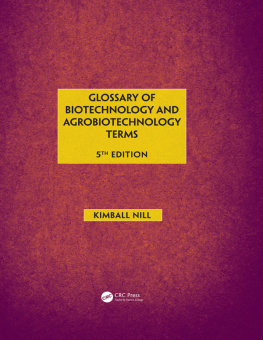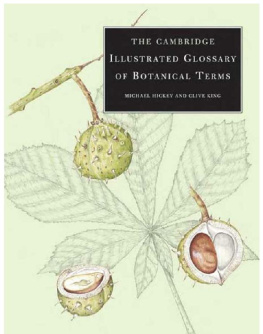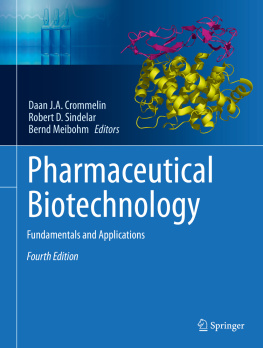Nill - Glossary of Biotechnology & Agrobiotechnology Terms 5e
Here you can read online Nill - Glossary of Biotechnology & Agrobiotechnology Terms 5e full text of the book (entire story) in english for free. Download pdf and epub, get meaning, cover and reviews about this ebook. year: 2016, publisher: CRC Press, genre: Romance novel. Description of the work, (preface) as well as reviews are available. Best literature library LitArk.com created for fans of good reading and offers a wide selection of genres:
Romance novel
Science fiction
Adventure
Detective
Science
History
Home and family
Prose
Art
Politics
Computer
Non-fiction
Religion
Business
Children
Humor
Choose a favorite category and find really read worthwhile books. Enjoy immersion in the world of imagination, feel the emotions of the characters or learn something new for yourself, make an fascinating discovery.
- Book:Glossary of Biotechnology & Agrobiotechnology Terms 5e
- Author:
- Publisher:CRC Press
- Genre:
- Year:2016
- Rating:4 / 5
- Favourites:Add to favourites
- Your mark:
- 80
- 1
- 2
- 3
- 4
- 5
Glossary of Biotechnology & Agrobiotechnology Terms 5e: summary, description and annotation
We offer to read an annotation, description, summary or preface (depends on what the author of the book "Glossary of Biotechnology & Agrobiotechnology Terms 5e" wrote himself). If you haven't found the necessary information about the book — write in the comments, we will try to find it.
Nill: author's other books
Who wrote Glossary of Biotechnology & Agrobiotechnology Terms 5e? Find out the surname, the name of the author of the book and a list of all author's works by series.
Glossary of Biotechnology & Agrobiotechnology Terms 5e — read online for free the complete book (whole text) full work
Below is the text of the book, divided by pages. System saving the place of the last page read, allows you to conveniently read the book "Glossary of Biotechnology & Agrobiotechnology Terms 5e" online for free, without having to search again every time where you left off. Put a bookmark, and you can go to the page where you finished reading at any time.
Font size:
Interval:
Bookmark:
An enzyme that specifically degrades (destroys) single-stranded sequences of DNA. See also Restriction endonucleases, Enzyme, Deoxyribonucleic acid ( DNA ).
See Sphingosine-1-phosphate .
Acronym for Selective Apoptotic Antineoplastic Drug . See Selective apoptotic antineoplastic drug ( SAAND ).
Senior Advisory Group on Biotechnology. See Senior Advisory Group on Biotechnology ( SAGB ).
Acronym for Serial Analysis of Gene Expression. See Serial analysis of gene expression ( SAGE ).
An herb, that when consumed by humans, has the effect of boosting the activity of CYP3A4 liver enzyme. Consumption of Saint Johns Wort together with a number of different modern pharmaceuticals could be risky for people because that heightened enzyme activity could cause too rapid metabolism of pharmaceuticals such as statins, certain chemotherapy drugs, birth control pills (and some other pharmaceuticals); so the typical dose could result in lower-than-expected bloodstream levels. See also Serotonin, CYP3A4, Cytochrome P4503A4, Enzyme, Commission e monographs .
SA is a plant hormone that is a signaling molecule in the Hypersensitive Response or Systemic Acquired Resistance (SAR) when SAR is triggered in plants (e.g., via spray application of COBRA herbicide to soybean plants, via spray application of harpin protein to various plants, via chewing by insects on the leaves of tomato plants, and/or the entry into plant of certain pathogenic bacteria/fungi, etc.).
Salicylic acid also helps many plants to modulate the microbiome (community of bacteria) within their root system, so that micro-biome helps to protect the plant from certain pathogens, assists roots in the uptake of nutrients, and so on.
Since at least the fifth century BC, mankind has consumed salicylic acid (e.g., in the form of dried willow or myrtle leaves then; in the form of aspirin now) to treat pain and inflammation. The name salicylic acid arose from Salix alba , the Latin name for the white willow tree.
Research indicates that human aspirin consumption correlates with halted growth of vestibular schwannomas (also known as acoustic neuromas); a potentially lethal intracranial tumor that typically causes hearing loss and tinnitus.
Research indicates that adequate human aspirin consumption correlates with a 30% decrease in colorectal cancer risk, except in people who possess rare single-nucleotide polymorphisms (SNPs) at sites on their chromosomes 12 and 15. The people possessing those rare variants actually increased their risk of colorectal cancer via daily aspirin consumption. See also Hypersensitive response, Systemic acquired resistance ( SAR ), Signaling molecule, Soybean plant, Harpin, Fungus, Pathogen, Protein, Pathogenesis-related proteins, Jasmonic acid, Azelaic acid, Alternative splicing, Tumor, Single-nucleotide polymorphisms ( SNPs ), Synthetic biology, Microbiome .
See Salt tolerance .
A genus of bacteria, consisting of more than 2400 serovars (strains/types) that are classified within two species ( Salmonella enterica and Salmonella bongori ). All of these serovars are potentially pathogenic (disease causing) to humans. For example, some variants of Salmonella typhimurium can cause typhoid fever. The nontyphoid strains of Salmonella generally cause enterocolitis; although that enterocolitis can lead to/become more serious systemic infections.
Salmonella enteritidis, Salmonella Heidelberg , and S. typhimurium are increasingly causing outbreaks of foodborne illnesses (e.g., when foods are not washed or cooked thoroughly enough prior to consumption by humans). See also Bacteria, Pathogen, Pathogenic, Strain, Salmonella enteritidis, Salmonella typhimurium, Salmonella heidelberg, Commensal .
A pathogenic strain of Salmonella bacteria which can cause gastroenteritis, nontyphoidal septicemia, or (serovar Typhi) the disease known as typhoid fever in humans. S. enterica can cause human macrophages to undergo apoptosis (programmed cell death), thereby enabling S. enterica to resist the human cellular immune response. See also Bacteria, Pathogen, Pathogenic, Strain, Salmonella, Macrophage, Cell, Cellular immune response .
A pathogenic strain of Salmonella bacteria which can cause gastroenteritis. S. enterica serovar Enteritidis can cause human macrophages to undergo apoptosis (programmed cell death), thereby enabling S. enterica to resist the human cellular immune response. See also Bacteria, Pathogen, Pathogenic, Strain, Salmonella, Macrophage, Cell, Cellular immune response .
A pathogenic strain of Salmonella bacteria, which can cause fatal infections in poultry and humans (e.g., when undercooked eggs are eaten by humans). See also Bacteria, Pathogen, Pathogenic, Strain, Salmonella .
A pathogenic and antibiotic-resistant strain of Salmonella bacteria, which can cause disease in humans (e.g., when contaminated food is not washed and cooked enough prior to consumption). See also Bacteria, Pathogen, Pathogenic, Strain, Commensal .
A pathogenic strain of Salmonella bacteria, which can cause disease in humans (e.g., when contaminated food is not washed and cooked enough prior to consumption). See also Bacteria, Pathogen, Pathogenic, Strain, Commensal .
Refers to the trait (of a plant) which enables a plant to grow/survive in soil that contains a high level of salt. For example, during 2001, Eduardo Blumwald and Hong-Xia Zhang inserted an AtNHX1 gene from Arabidopsis thaliana into a tomato plant ( Lycopersicon esculentum ) and thereby made that tomato plant resistant to salt concentrations up to 200 mM (i.e., far higher than it could previously survive).
That ( Arabidopsis -origin) gene enables the tomato plant to extract salt from the soil and then sequester and store the salt in vacuoles (i.e., small compartments) within its leaf cells.
For example, during 2014, Lijuan Qiu and Rongxia Guan discovered a salt tolerance gene present in the DNA of wild-type soybean plants that are the ancestors of todays domesticated soybean ( Glycine max (L.) Merrill) varieties. Because todays domesticated soybean varieties do not possess that salt tolerance gene, a soybean breeder wanting to create a modern soybean variety that would grow well in salty soil could utilize a wide cross between a modern soybean variety (germplasm) and one of those salt-tolerant wild-type soybean species (i.e., retrieved from one of the seed banks utilized to store ancestral crop-plant relatives).
See also Arabidopsis thaliana, Vacuoles, Tomato, Antiporter, Phenomics, Wild type, Germplasm, Traditional breeding methods, Native trait restoration, Soybean plant, Wide cross, Deletions .
A technique used for forcing (dissolved) proteins out of a solution by increasing the concentration of salt in the solution. The Na+ and Cl ions derived from the salt compete for and tie up water molecules that are solubilizing the protein molecules thereby rendering them insoluble or more insoluble. See also Protein .
See Sam-K gene .
A gene that is naturally present within the E. coli bacteriophage T3 .
If the sam-k gene is inserted via genetic engineering into a (fruit crop) plants genome, that causes greatly reduced production of the chemical compound S -adenosylmethionine (SAM) in that plants fruit.
Font size:
Interval:
Bookmark:
Similar books «Glossary of Biotechnology & Agrobiotechnology Terms 5e»
Look at similar books to Glossary of Biotechnology & Agrobiotechnology Terms 5e. We have selected literature similar in name and meaning in the hope of providing readers with more options to find new, interesting, not yet read works.
Discussion, reviews of the book Glossary of Biotechnology & Agrobiotechnology Terms 5e and just readers' own opinions. Leave your comments, write what you think about the work, its meaning or the main characters. Specify what exactly you liked and what you didn't like, and why you think so.








